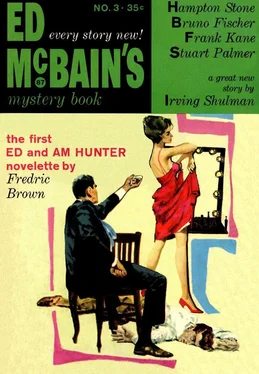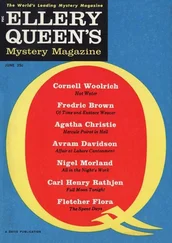Фредерик Браун - Ed McBain’s Mystery Book, No. 3,1961
Здесь есть возможность читать онлайн «Фредерик Браун - Ed McBain’s Mystery Book, No. 3,1961» весь текст электронной книги совершенно бесплатно (целиком полную версию без сокращений). В некоторых случаях можно слушать аудио, скачать через торрент в формате fb2 и присутствует краткое содержание. Город: New York, Год выпуска: 1961, Издательство: Pocket Books, Жанр: Детектив, на английском языке. Описание произведения, (предисловие) а так же отзывы посетителей доступны на портале библиотеки ЛибКат.
- Название:Ed McBain’s Mystery Book, No. 3,1961
- Автор:
- Издательство:Pocket Books
- Жанр:
- Год:1961
- Город:New York
- ISBN:нет данных
- Рейтинг книги:4 / 5. Голосов: 1
-
Избранное:Добавить в избранное
- Отзывы:
-
Ваша оценка:
- 80
- 1
- 2
- 3
- 4
- 5
Ed McBain’s Mystery Book, No. 3,1961: краткое содержание, описание и аннотация
Предлагаем к чтению аннотацию, описание, краткое содержание или предисловие (зависит от того, что написал сам автор книги «Ed McBain’s Mystery Book, No. 3,1961»). Если вы не нашли необходимую информацию о книге — напишите в комментариях, мы постараемся отыскать её.
Ed McBain’s Mystery Book, No. 3,1961 — читать онлайн бесплатно полную книгу (весь текст) целиком
Ниже представлен текст книги, разбитый по страницам. Система сохранения места последней прочитанной страницы, позволяет с удобством читать онлайн бесплатно книгу «Ed McBain’s Mystery Book, No. 3,1961», без необходимости каждый раз заново искать на чём Вы остановились. Поставьте закладку, и сможете в любой момент перейти на страницу, на которой закончили чтение.
Интервал:
Закладка:
Herlehy watched the play of emotion on the girl’s face. “Even so, why should she kill Davis?”
“It was getting too hot. Maybe he raised the ante. Maybe he wanted it all, huh, Lorna? With you thrown in for a bonus?” The blonde stared at him, started to back away. “You kept me here while he went to scare the redhead,” Liddell continued. “That bit of spilling the liquor on the dress was pretty transparent. But I couldn’t figure out why. When I found the redhead dead, I knew.”
The girl started to shake uncontrollably. “You’re wrong,” she muttered. “All wrong.”
Liddell shook his head. “We haven’t got all the pieces yet, chickie. But now that we know where to look, it won’t take long.”
The blonde continued to stare at him for a moment, then with a scream, she turned and ran for the balcony. Liddell looked away, heard the Inspector swear as he started after her. When Liddell looked up, the balcony was empty. The Inspector was leaning over the edge, looking down.
From somewhere below there was the sound of a soul in agony, then with breath-taking suddenness, there was quiet.
Break-Out
by Donald E. Westlake
Alcatraz is probably the toughest and best-known prison in the United States, long considered an impregnable, escape-proof penitentiary. The entire imprisoned population there consists of hard cases transferred from less rugged federal penitentiaries. In the middle of San Francisco Bay, it is surrounded by treacherous currents and is almost always enveloped by thick fog and high winds. A high percentage of the prisoners sent there are men who have already escaped from one or more other prisons and penitentiaries. “Now you are at Alcatraz,” they are told. “Alcatraz is escape-proof. You can’t get away from here.”
It was a challenge, and sooner or later someone had to accept it. That someone was a felon named Ted Cole. Cole had already escaped once, from an Oklahoma prison, where he had been assigned duty in the prison laundry. That escape had been made by hiding in a laundry bag. But now Cole was on Alcatraz, and Alcatraz, he was told repeatedly, was escape-proof.
Cole’s work assignment was in the prison machine shop, which suited him perfectly. Through an involved code in his infrequent mail, he managed to line up outside assistance from friends in the San Francisco area. While waiting for things to be set up outside, he spent a cautious part of each workday on the machine-shop wall, on the other side of which was the rocky, surf-torn beach of the island.
The day finally came. Leaving right after a head count, so he would have an hour or two anyway before his absence was noticed, Cole went through the machine-shop wall and dove into the water, swimming straight out from the island, the fog so thick around him he could barely see the movement of his own arms as he swam.
This, as far as he was concerned, was the only really dangerous part of the escape. If his friends couldn’t find him in the fog, he would simply swim until he drowned from exhaustion or was recaptured by a police patrol from the island.
Finally, a launch came out of the fog ahead, throttling down beside him, and Cole treaded water, staring anxiously, wondering whether this was escape or capture.
It was escape. His friends fished him out of the water, gave him blankets and brandy, and the launch veered away toward shore. Yet again, society’s challenge had been accepted, and another “escape-proof” prison had been conquered.
Accepting society’s challenge in his own antisocial way is second nature to the habitual criminal. The desire for freedom is strong in most men, and perhaps it is strongest in those who have, by the commission of crime, tried to free themselves from the restraint of society’s laws. The much harsher and much more complete restraint of a narrow prison cell and an ordered, repetitive existence within the prison walls, plus the challenge of being told that escape from this prison is impossible, increase this yearning for freedom to the point where no risk seems too great, if only there is the possibility of freedom. No matter what the builders of the prison have claimed, the imaginative and determined prisoner can always find somewhere, in a piece of wood or a rusty nail or the manner of the guards’ shift changes, the slim possibility that just might end in freedom.
This yearning for freedom, of course, doesn’t always result in imaginative and ingenious escapes. At times, it prompts instead wholesale riots, with hostages taken and fierce demands expressed and the senseless destruction of both lives and property. Such outbreaks are dreaded by prison officials, but they never result in successful escapes. They are too noisy and too emotional. The successful escapee is silent, and he uses his wits rather than his emotions.
The prisoner who is carefully working out the details of an escape, in fact, dreads the idea of a riot fully as much as do the prison officials themselves.
The result of a riot is inevitably a complete search and shakedown of the entire prison. And this means the discovery of the potential escapee’s tunnel or hacksaw or dummy pistol or specially constructed packing case or rope ladder or forged credentials. And the escapee has to think of some other plan.
He always does. No matter how tight the control, how rigid the security, how frequent the inspections or “impregnable” the prison, the man who desires freedom above all other things always does think of something else.
Take John Carroll, perhaps the only man ever to break both out of and into prison. In the twenties, Carroll and his wife, Mabel, were known throughout the Midwest as the Millionaire Bandits. Eventually captured and convicted, John Carroll was sentenced to Leavenworth while Mabel was imprisoned at the women’s reformatory at Leeds.
At that time, in 1927, Leavenworth was still thought of as being nearly escape-proof, and the constant shakedowns and absolutely rigid daily schedule had Carroll stymied for a while. But not forever.
Carroll had been put to work in the machine shop, and he spent months studying the guards, realizing that he would be much more likely to escape if he could get one of them to collaborate with him.
He finally picked the shop foreman himself, a truculent, middle-aged, dissatisfied guard obviously unhappy in his work. Carroll waited in the machine shop one afternoon until everyone else had left and he was alone with the foreman. The foreman wanted to know what he was still doing here. Carroll, making the big leap all at once, said, “How would you like to make thirty-four thousand dollars?”
The foreman showed neither interest nor shock. Instead, he demanded, as though it were a challenge, “How do I do that?”
“I have sixty-eight thousand hidden on the outside,” Carroll told him. “Help me get out of here, and half of it is yours.”
The foreman shook his head and told Carroll to go on with the others. But the next day, when work was finished, he signaled to Carroll to stay behind again. This time, he wanted to know what Carroll’s plans were.
Carroll told him. A part of the work in this shop was devoted to building the packing cases in which the convict-made goods were shipped outside. Carroll and the foreman would construct a special case and when Carroll felt the time was right, the foreman would help him ship himself out of prison and to the foreman’s apartment.
The foreman agreed, and they went to work. Carroll was a cautious man, and they worked slowly, nor did Carroll make his escape immediately after the special packing case was completed. Instead, he waited for just the right moment.
A note from his wife, delivered through the prison grapevine, forced Carroll to rush his plans. The note, which he received on February 28th, 1927, read: “Your moll has t.b. bad. I’ll die if you don’t get me out. I’m in Dormitory D at Leeds.”
Читать дальшеИнтервал:
Закладка:
Похожие книги на «Ed McBain’s Mystery Book, No. 3,1961»
Представляем Вашему вниманию похожие книги на «Ed McBain’s Mystery Book, No. 3,1961» списком для выбора. Мы отобрали схожую по названию и смыслу литературу в надежде предоставить читателям больше вариантов отыскать новые, интересные, ещё непрочитанные произведения.
Обсуждение, отзывы о книге «Ed McBain’s Mystery Book, No. 3,1961» и просто собственные мнения читателей. Оставьте ваши комментарии, напишите, что Вы думаете о произведении, его смысле или главных героях. Укажите что конкретно понравилось, а что нет, и почему Вы так считаете.



